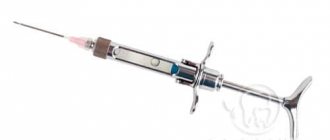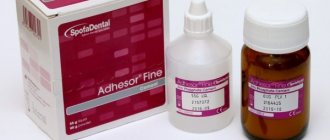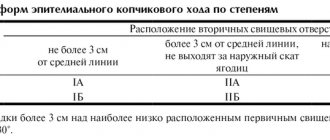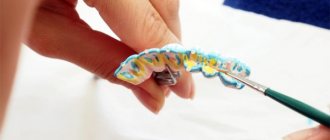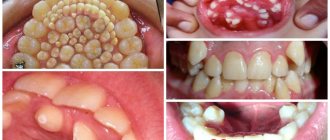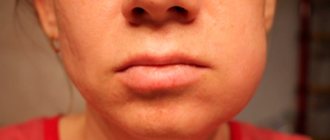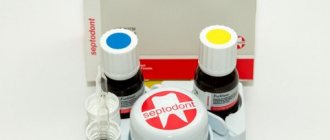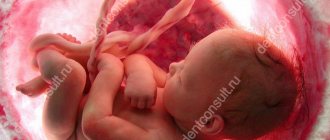Glass ionomer cement Cemion F is intended for:
- fixation of crowns, bridges and orthodontic structures;
- fixing tabs and pins
Glass ionomer cement Cemion F is formed by mixing powder and liquid.
The powder is crushed aluminofluorosilicate glass, the liquid is an aqueous solution of polyacrylic acid.
Cemion F is radiopaque, has high mechanical strength, low solubility, good adhesion to enamel, dentin and basic structural dental materials, and meets the requirements of GOST R 51744-2001.
Cemion F provides good marginal sealing, releases fluoride for a long time, which strengthens the hard tissues of the tooth and prevents the development of secondary caries.
Glass ionomer cement Cemion-F does not cause pain in the patient when fixing crowns and bridges.
Action of Cemion
When the powder is mixed with a liquid, it exhibits a glass ionomer reaction. Dentin is strengthened thanks to fluoride ions, which have a cohesive effect. Glass ionomer cement Cemion is known for its disinfecting properties. It is a preventive material and prevents the development of secondary caries; this effect is achieved through prolonged exposure to fluoride. Means:
- compatible with tooth structure;
- has a strength of 15 MPa;
- resistant to acid erosion;
- fits firmly;
- has radiopaque properties.
Cemion ART (ART) is used to treat baby teeth, secure temporary fillings, and restore teeth under a crown. They eliminate wedge-shaped defects, enamel erosion, and fill open cavities of classes 1, 2 and 5. This is an excellent base for lining when filling with composites and amalgam.
Release forms and components
The material is produced in the form of glass ionomer cement, which has a chemical cure.
Cement has chemical adhesion to dentin and enamel. The process of formation of filling material occurs during the combination of powder and liquid, which are included in the kit. The structure of the powder is crushed aluminofluorosilicate glass. Liquid is an aqueous solution that is obtained from polyacrylic acid in a modified form.
On sale it is found in the form of a set of powder, solution, conditioner and topcoat. The powder has an A2 shade, its volume is 20 grams, the liquid volume is 20 ml, the conditioner is 10 ml, the protective coating varnish is 10 ml. Additionally, the kit includes a measuring cup, a dropper cap, applicators in the amount of 10 pieces, and a notebook for diluting cement.
Instructions for use
During transportation, the product is stored at sub-zero temperatures, so before use it is recommended to leave it in a warm place for about an hour and then shake it. The dose is measured using a special spoon. It is filled to the end, and the excess is removed with a small spatula. The dropper with which Cemion is poured is held with arms raised vertically. This ensures that the liquid drops accurately.
Mix the cement on glass or a notepad. Do this with a plastic or metal spatula. To avoid freezing, stir the ingredients every half minute.
You can use the product in two ways. If you need to make a gasket for insulation, mix 0.28 grams of powder with 2 drops of liquid. At room temperature, cement hardens in 3 minutes. If the air temperature is higher, the working time of the product is reduced, so it is necessary to work with cement on a cold table. The mixture will completely harden 5 minutes after mixing.
If Cemion universal is needed for fissures, you will need a double portion of the powder. It is diluted with 3 drops of solution. At room temperature, the working time of the product is a couple of minutes. You need to knead it on glass or a notepad. The final hardening of the cement occurs in 3-4 minutes.
Before using Cemion, the doctor pre-treats the working cavity. The prepared area is washed and dried, and conditioned. This improves the adhesion characteristics of the cement to the tooth. The conditioner is applied with a brush or cotton swab. It is clearly visible due to its blue color. The next stage is to pour water over the area and blow it with air to dry it. In this case, do not use a powerful stream of air, otherwise the varnish may move. After the procedure, the area usually looks perfectly clean, with no signs of fluid.
There is no residual acid in the cement mass, so the risk of development from the pulp and oral mucosa is minimal. It goes through a rubber-like stage during which chemical bonding occurs.
The gasket is done before conditioning. If after the procedure the structure of the pad is disturbed, an additional portion of Cemion must be applied. The first time after hardening, the product will react violently to moisture. To reduce the reaction, the surface of the cement is varnished with a special stick or applicator. It is then air dried for 10-15 seconds.
You can work with the filling and polish it after fifteen minutes. This allows you to create the correct bite. Grind and polish the filling no later than after 24 hours. Afterwards the surface is again varnished with a protective layer.
Instructions for Cemion F
Before using glass ionomer cement Cemion F, the jar of powder must be shaken well. The powder is dosed with a measuring spoon, the liquid is dosed with a dropper. It is recommended to mix powder and liquid in a weight ratio of 1.9:1, which corresponds to 1 scoop of powder without top (0.29 g) and 3 drops of liquid (0.15 g).
Glass ionomer cement Cemion F is mixed on glass with a plastic or metal spatula in portions for 30 seconds. At a temperature of +23+1 °C and a relative air humidity of 45-55%, the working time of cement is 2.5-3.0 minutes. As the temperature rises, the working time of cement is reduced; the material should be mixed on cooled glass. Hardening time in the mouth is 5-6 minutes.
Fixation is carried out using the generally accepted method. To improve the adhesion of cement to dentin, a tooth prepared for cementation is treated with a conditioner (applied with a brush or applicator for 15-20 seconds), then thoroughly washed with plenty of water and dried with air. Overdrying should be avoided. Treatment with conditioner is possible only on pulpless teeth, since during fixation significant hydraulic pressure is created and it is undesirable to have open dentinal tubules.
Excess cement is removed after 10-12 minutes. after fixation of dentures and orthodontic structures.
Along the lower border of the crown, it is necessary to apply a layer of Cemion topcoat varnish to protect the glass ionomer from exposure to the humid environment of the oral cavity during the first hour of its hardening.
It is recommended to wash metal instruments immediately after use with water or a disinfectant.
Precautionary measures
When using Cemion, doctors follow strict rules:
- They check whether the applicant has an individual intolerance to the drug. If it is discovered, they refuse to use it.
- Before processing the filling, the instruments are lubricated with Vaseline; no water is used.
- Apply Cemion carefully so that it does not get into the mouth or onto the skin around it. If such a situation occurs, quickly remove the component.
- If liquid or conditioner gets into your eyes, rinse them immediately with water.
- After using Cemion, immediately wash metal instruments under water or treat them with a disinfectant.
Material properties
When mixing the powder with the liquid, a glass ionomer reaction occurs almost immediately. During the reaction, fluoride ions are released, which have a strengthening effect on the dentin structure. This product also has a disinfecting effect and prevents the occurrence of secondary carious lesions.
In addition, Cemion universal has other properties:
- the product is biologically compatible with the structure of dental tissues;
- has an increased level of strength up to 15 MPa;
- has increased resistance to acid erosion;
- when applied, creates a strong marginal seal;
- has radiopaque qualities.
Price
Cemion can be ordered online or at dental supply outlets. The price of Cemion F is 450-500 rubles. Cemion F is used when installing bridges, orthodontic structures, pins and inlays. It meets the rules of GOST R 51744-2001.
According to the VITA standard, several shades of cement powder are distinguished:
- Tsemion A2;
- Tsemion A3;
- AT 2;
- C2;
- C4.
The product does not cause pain in the patient.
Scope of application
This remedy is used in the following cases:
- for restoration of milk teeth (all classes of cavities);
- for filling open cavities with the first and second class, as well as sealing fissures;
- for filling cavities of the fifth class, but only if aesthetic factors are not considered the main ones;
- often used during the treatment of non-carious lesions of hard tissues, for example, to eliminate wedge-shaped defects and erosive lesions of enamel;
- used to install temporary fillings during long-term therapy;
- for restoration of damaged or destroyed tooth tissue under the crown;
- This product is used as a lining during fillings with composites and amalgam.
Storage conditions
The Cemion set should be placed in a dark place at a temperature from 5 degrees to 25. It is important to keep all jars with Cemion permanently sealed so that moisture does not get into them. If the storage rules are followed, the shelf life of the product is 2 years. If Cemion F VladMiVa will be transported in winter, at air temperatures below 0, before that it should be kept at room temperature for 24 hours.
Analogues are the German products “Ketak Molar ART”, “Espe”. And materials from other manufacturers: Argetsem, Vitremer, Kemfil Superior, Ketak Cem, Meron, Tsemfil 15.
Cemion cement greatly facilitates the dental practice. Its correct use, taking into account the pros and cons, provides wide opportunities in dentistry. This is one of the most effective means for fixing crowns and inlays.
special instructions
Dentists should adhere to the following guidelines when using glass ionomer:
- if the patient is allergic to the material, it is necessary to remove the substance and refuse its further use;
- during use, the solution should not be allowed to come into contact with the surface of the soft tissues of the oral cavity and skin; if this suddenly happens, the components should be washed off with water;
- If liquid or conditioner gets into your eyes, rinse them immediately with plenty of water and seek medical attention.
Purpose:
Designed for fixing crowns, bridges and orthodontic structures, fixing inlays and pins.
Composition and main properties:
Glass ionomer cement "Cemion-F" is formed by mixing powder and liquid. The powder is crushed aluminofluorosilicate glass, the liquid is an aqueous solution of polyacrylic acid.
"Cemion-F" is radiopaque, has high mechanical strength, low solubility, good adhesion to enamel, dentin and basic structural dental materials. The material provides good marginal sealing and releases fluoride for a long time, which strengthens the hard tissues of the tooth and prevents the development of secondary caries.
Glass ionomer cement "Cemion-F" does not cause pain in the patient when fixing crowns and bridges.
Instructions for use:
Before using glass ionomer cement Cemion F, the jar of powder must be shaken well. The powder is dosed with a measuring spoon, the liquid is dosed with a dropper. It is recommended to mix powder and liquid in a weight ratio of 1.9:1, which corresponds to 1 scoop of powder without top (0.29 g) and 3 drops of liquid (0.15 g).
Glass ionomer cement Cemion F is mixed on glass with a plastic or metal spatula in portions for 30 seconds. At a temperature of +23+1 °C and a relative air humidity of 45-55%, the working time of cement is 2.5-3.0 minutes. As the temperature rises, the working time of cement is reduced; the material should be mixed on cooled glass. Hardening time in the mouth is 5-6 minutes.
Fixation is carried out using the generally accepted method. To improve the adhesion of cement to dentin, a tooth prepared for cementation is treated with a conditioner (applied with a brush or applicator for 15-20 seconds), then thoroughly washed with plenty of water and dried with air. Overdrying should be avoided. Treatment with conditioner is possible only on pulpless teeth, since during fixation significant hydraulic pressure is created and it is undesirable to have open dentinal tubules.
Excess cement is removed after 10-12 minutes. after fixation of dentures and orthodontic structures.
Along the lower border of the crown, it is necessary to apply a layer of Cemion topcoat varnish to protect the glass ionomer from exposure to the humid environment of the oral cavity during the first hour of its hardening.
Package:
Powder – 20 g
Liquid – 15 ml
Conditioner - 10 ml

